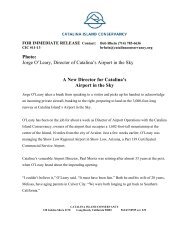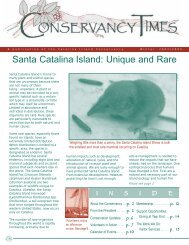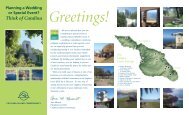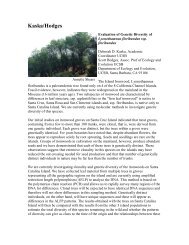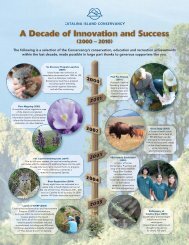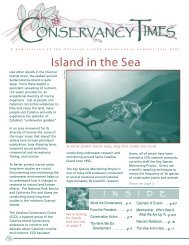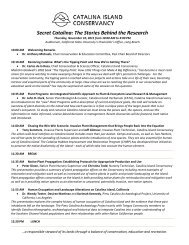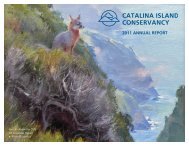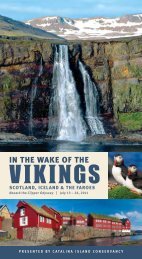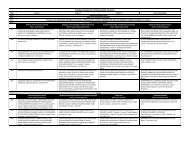Getting Out is Really Getting Inâ¦Into the Interior - Catalina Island ...
Getting Out is Really Getting Inâ¦Into the Interior - Catalina Island ...
Getting Out is Really Getting Inâ¦Into the Interior - Catalina Island ...
You also want an ePaper? Increase the reach of your titles
YUMPU automatically turns print PDFs into web optimized ePapers that Google loves.
Conservation Updates<br />
Counting Marine Mammals Along<br />
<strong>Catalina</strong>’s Coastline<br />
May 14 th was a cool, cloudy morning and <strong>the</strong> mostly calm seas<br />
reg<strong>is</strong>tered a chilly 60 degrees, but th<strong>is</strong> did not deter numerous<br />
California Sea Lions (Zalophus californianus) from frolicking about<br />
in <strong>the</strong> waters of Avalon Harbor, along Pebbly Beach and on past<br />
<strong>the</strong> quarry. As we approached Seal Rocks, it became obvious that it<br />
was going to be an amazing day to view marine mammals. Using<br />
binoculars, we counted at least 117 sea lions hauled out on <strong>the</strong><br />
rocks and beaches of <strong>the</strong> Seal Rocks area. Several more could be<br />
seen darting back and forth amongst a pod of Common Bottlenose<br />
Dolphins (Tursiops tuncatus) traveling through <strong>the</strong> nearby waters.<br />
<strong>Catalina</strong>’s ecosystems are not only essential for terrestrial plants and animals, but also for marine mammals,<br />
such as seals and sea lions, which use <strong>the</strong> <strong>is</strong>land’s numerous beaches and offshore rocks to haul out for<br />
important activities such as molting and pupping.<br />
Each spring and fall, Conservancy biolog<strong>is</strong>ts conduct a census of <strong>the</strong> marine mammals that use <strong>the</strong> <strong>is</strong>land’s<br />
various beaches and offshore rocks. The census records <strong>the</strong> number and type of marine mammals in order to<br />
monitor how <strong>the</strong>ir populations fluctuate through time. Th<strong>is</strong> spring’s count was our fifth and largest census<br />
ever. With <strong>the</strong> help of volunteer Captain Scott Wauben and h<strong>is</strong> boat Dulcinea, we began our clockw<strong>is</strong>e<br />
circumnavigation of <strong>the</strong> <strong>is</strong>land at around 7 AM.<br />
As we proceeded around <strong>the</strong> far East End of <strong>the</strong> <strong>is</strong>land and just west of Binnacle Rock, we came across our first<br />
sighting of Harbor Seals (Phoca vitulina), a group of 35, including a few young pups, hauled out on <strong>the</strong> beach<br />
and not <strong>the</strong> least bit interested in our position 200-300 feet offshore. Continuing westward we came across<br />
even larger congregations of Harbor Seals hauled out on <strong>the</strong> beaches between China Point and Ben Weston,<br />
with several groups numbering more than 50 individuals. Then at Land’s End, we observed ano<strong>the</strong>r large<br />
assemblage of sea lions, 35 th<strong>is</strong> time, lounging on some offshore rocks.<br />
The surf had become increasingly choppy as we rounded Land’s End and we were all ready for a change of<br />
pace as <strong>the</strong> waves began to flatten out and our peaceful journey resumed once more on <strong>the</strong> Channel side of<br />
<strong>the</strong> <strong>is</strong>land. As we traveled past <strong>the</strong> coves and Isthmus, we continued to record seal and sea lion sightings both<br />
in <strong>the</strong> water and hauled out on rocks and beaches along <strong>the</strong> way. However, a wonderful surpr<strong>is</strong>e still awaited<br />
us on a beach near Frog Rock. There we observed a female Nor<strong>the</strong>rn Elephant Seal (Mirounga angustirostr<strong>is</strong>), a<br />
new marine mammal for our species l<strong>is</strong>t, hauling out of <strong>the</strong> water. It was approximately 2 PM when we pulled<br />
back into Avalon Harbor and our census was concluded.<br />
Overall, 565 pinnipeds were observed that day, 285 seals (two species) and 280 sea lions, making it our largest<br />
count ever. The fact that pinniped numbers were three times greater than those for past spring counts suggest<br />
that prey items, such as squid and anchovy, may have been extremely plentiful in <strong>Catalina</strong>’s waters at <strong>the</strong> time<br />
of <strong>the</strong> census, perhaps attracting seals and sea lions from o<strong>the</strong>r areas to <strong>the</strong> <strong>is</strong>land.<br />
Angela Aarhus<br />
Field Biolog<strong>is</strong>t<br />
Helping Hands<br />
The Facilities Management Department gives a heartfelt thank you to <strong>the</strong> following volunteers for all of<br />
<strong>the</strong>ir efforts: NCCC Western Region Americorps, Jani E<strong>is</strong>enhut, Fred Freeman, David Larsen, Tracy Larsen, Paul McIlroy, Calvin<br />
Parsons, Richard Pelouze, Bruce Seibert, and Chr<strong>is</strong> Messett U.C.L.A.<br />
6<br />
<strong>Catalina</strong> <strong>Island</strong> Conservancy





